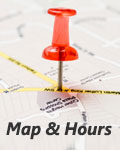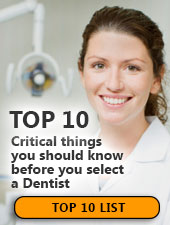Call (818) 688-4971
Oral Hygiene - Post Treatment Home Care
We want you to keep your teeth and gums healthy for a lifetime. We are happy to explain and demonstrate proper home care. However, responsibility for your oral health ultimately lies with you. Yes, it is really up to you to keep things on the right track. If you do the following every day, you will significantly increase the likelihood of a lifetime of good oral health.
Floss
Floss is used to remove plaque and whatever else decides to take refuge on your teeth, both above and below the gum line. Plaque refers to the bacteria and other things that stick to your teeth. There is direct connection between plaque, gum disease and tooth decay. Therefore, if you don’t remove the plaque, you will get gum disease and tooth decay.
Glide Floss is one of top floss products currently available. It is designed not to shred or get caught on your teeth or fillings. Take about an 18 inch length of floss and wrap it around your 2 middle fingers. Hold about a 1 inch length of this floss between the thumb and forefinger of each hand, keeping it tight. Gently place this 1 inch tight piece between the tooth contact. When you reach the gum line, hold the floss against one tooth and move it into the space between the gum and tooth below the gum line. While keeping the floss in contact with the tooth, move it up and down along the side of the tooth, from just below the contact to as far as you can comfortably get below the gum line. It is important that you get the floss in the space between the gum and tooth, as this is where gum disease begins. Repeat this procedure for the tooth on the other side of the contact. As you move from tooth to tooth, use a fresh section of floss.
If you haven’t flossed in awhile, your gums may bleed at first when you do this. If you are doing it correctly (and at least once a day), your gums will start to heal and the bleeding should stop in no more than 2 weeks.
Brush/Toothpaste
Brushing removes plaque and food debris on the chewing, inside and outside tooth surfaces. After flossing, use a soft brush along with a fluoride containing brand-name toothpaste. For the inside and outside surfaces, hold the brush at a 45 degree angle to the teeth and gums and use a gentle back-and-forth motion. This technique will not only clean your teeth, it will also keep your gums healthy. It is important to have the brush contact the teeth and gums at the same time. On the chewing surfaces hold the brush flat and use a gentle scrubbing motion.
Brush for two minutes. That is a long time, but it will be much more effective than the 20-30 seconds that most people do. Since two minutes standing by the sink is much longer than most people think, you may benefit by using a toothbrush timer. Brush at least 2 times a day, especially in the morning and at bedtime.
When done, spit out as much as you can. Don’t swallow any of the toothpaste, and don’t rinse out with any water.
Scrape
A tongue scraper is great for removing bacteria and food debris on the tongue. These substances get stuck in the deep crevices of your tongue, and if not removed, the byproducts give you bad breath. After brushing, a tongue scraper followed by a rinse is frequently the best way to control bad breath.
The tongue scraper we give you has two sides, regular and soft. Usually you will use the regular side.
Hold the scraper with two hands, between the thumbs and forefingers. Bend the scraper so that it forms a “C”. Stick out your tongue and start scraping from back to front several times. You will notice a creamy film develop on the scraper. Rinse it off. Repeat the scraping and rinsing until the film coming off your tongue is clear.
Rinse and dry the tongue scraper. It is designed to last a long time.
Rinse
An antibacterial rinse is just that, a rinse that cuts down on the bacteria that causes gum disease and cavities, plus it reduces those bacteria and the bacterial byproducts that cause bad breath. After scraping your tongue, it is recommended that you use a non-alcoholic anti-bacterial rinse, such as BreathRx or Crest Pro Health Rinse. This will significantly decrease the bacteria and volatile sulfur compounds (the substances responsible for bad breath). It will improve the health of your mouth and you will be a delight to be near. Why a non-alcoholic rinse? Most mouth rinses (such as Scope) contain a high percentage of alcohol. Alcohol dries your mouth out. Just put some alcohol on your hand and observe how quickly the skin dries out. Using a mouth rinse with a high alcohol content may make your mouth smell nice for only a short period of time. Once the alcohol begins drying the tongue and gums, your breath can actually smell worse than before you used it. Therefore, an alcoholic mouth rinse is not recommended.
Use a very small amount (you need less than you think) of mouth rinse and swish for 10-15 seconds and spit it out. No rinsing with water.
Remember: You don’t have to clean all your teeth; only the ones you want to keep. Congratulations! You are on your way to excellent oral health.
Call for an appointment:
(818) 688-4971
Make an Appointment
Don't Forget to Floss!
Clean between teeth daily with floss or an interdental cleaner. Decay-causing bacteria can hide between teeth where toothbrush bristles can't reach. Flossing helps remove plaque and food particles from between teeth and under the gum line.
Visit Our Office Regularly!
Take good care of your smile. Remember to visit the dentist regularly for professional cleanings and oral exams.
Mouthwash Is Important, Too!
Brushing and flossing may not be enough. The ADA now recommends using an antimicrobial mouthwash to reduce plaque and prevent gingivitis.
Convenient Appointments!
We are proud to offer you convenient before and after work or school appointments. Call today to schedule an appointment.
We Will Maximize Your Insurance Coverage!
Our experienced staff is here to help get the most from your insurance coverage.
Your Phone Number Here
Your Phone Number Here



